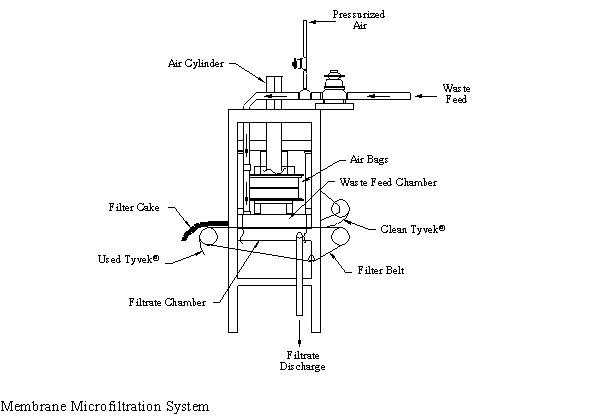
This membrane microfiltration system is designed to remove solid particles from liquid wastes, forming filter cakes typically ranging from 40 to 60 percent solids. The system can be manufactured as an enclosed unit, requires little or no attention during operation, is mobile, and can be trailer-mounted.
The membrane microfiltration system uses an automatic pressure filter (developed by Oberlin Filter Company), combined with a special Tyvek® filter material (Tyvek® T-980) made of spun-bonded olefin (invented by E.I. DuPont de Nemours and Company) (see figure below). The filter material is a thin, durable plastic fabric with tiny openings about 1 ten-millionth of a meter in diameter. These openings allow water or other liquids and solid particles smaller than the openings to flow through. Solids in the liquid stream that are too large to pass through the openings accumulate on the filter and can be easily collected for disposal.

The automatic pressure filter has two chambers: an upper chamber for feeding waste through the filter, and a lower chamber for collecting the filtered liquid (filtrate). At the start of a filter cycle, the upper chamber is lowered to form a liquid-tight seal against the filter. The waste feed is then pumped into the upper chamber and through the filter. Filtered solids accumulate on the Tyvek® surface, forming a filter cake, while filtrate collects in the lower chamber. Following filtration, air is fed into the upper chamber at a pressure of about 45 pounds per square inch. Air removes any liquid remaining in the upper chamber and further dries the filter cake. When the filter cake is dry, the upper chamber is lifted, and the filter cake is automatically discharged. Clean filter material is then drawn from a roll into the system for the next cycle. Both the filter cake and the filtrate can be collected and treated further before disposal, if necessary.
This membrane microfiltration system may be applied to (1) hazardous waste suspensions, particularly liquid heavy metal- and cyanide bearing wastes (such as electroplating rinsewaters), (2) groundwater contaminated with heavy metals, (3) constituents in landfill leachate, and (4) process wastewaters containing uranium. The technology is best suited for treating wastes with solids concentrations of less than 5,000 parts per million; otherwise, the cake capacity and handling become limiting factors. The system can treat any type of solids, including inorganics, organics, and oily wastes, with a wide variety of particle sizes. Moreover, because the system is enclosed, it can treat liquid wastes that contain volatile organics.
The membrane microfiltration system, accepted into the SITE Program in 1988, was demonstrated at the Palmerton Zinc Superfund site in Palmerton, Pennsylvania. The demonstration was conducted over a 4-week period in April and May 1990. Groundwater from the shallow aquifer at the site was contaminated with dissolved heavy metals, including cadmium, lead, and zinc. This contaminated groundwater served as the feed waste for the demonstration. The system treated waste at a rate of about 1 to 2 gallons per minute.
The Applications Analysis Report (EPA/540/A5-90/007), the Technology Evaluation Report (EPA/540/5-90/007), and a videotape of the demonstration are available from EPA.
Since 1991, about 12 commercial installations of the technology have been operational.
During the demonstration at the Palmerton Zinc Superfund site, the membrane
microfiltration system achieved the following results:
EPA PROJECT MANAGER:
John Martin
U.S. EPA
National Risk Management Research Laboratory
26 West Martin Luther King Drive
Cincinnati, OH 45268
513-569-7758
Fax: 513-569-7620
TECHNOLOGY DEVELOPER CONTACT:
Ernest Mayer
E.I. DuPont de Nemours and Company
Nemours 6440
1007 Market Street
Wilmington, DE 19898
302-774-2277
Fax: 302-368-0021